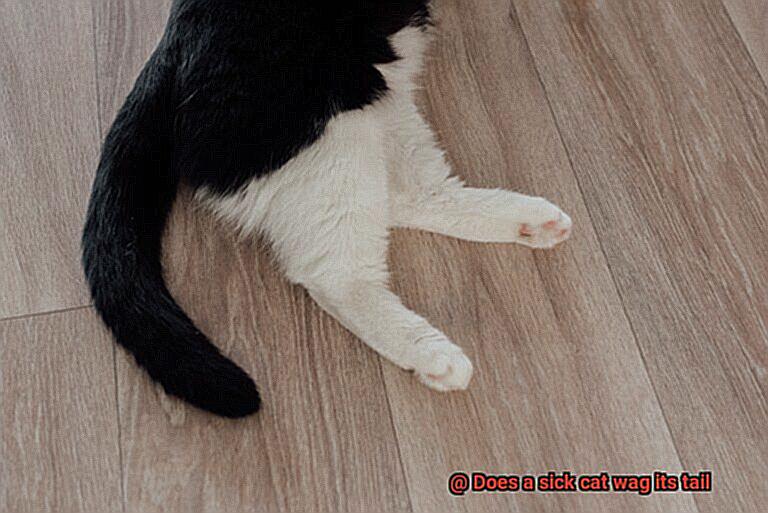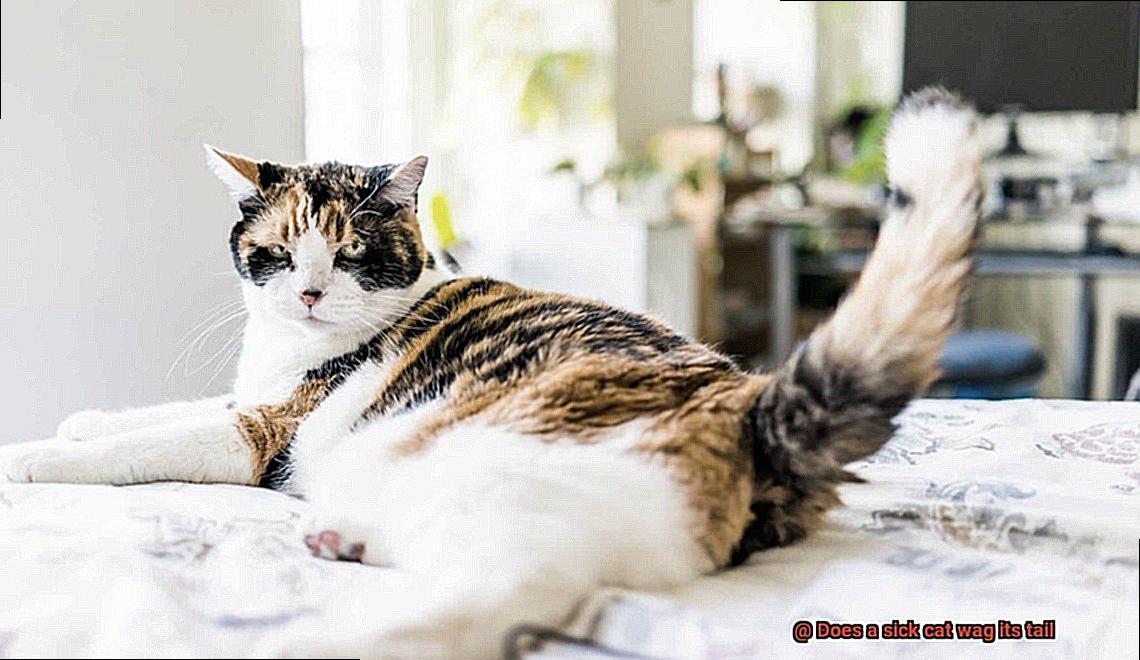Is your feline friend feeling a bit off lately, yet still wagging their tail? As cat owners, it’s crucial to understand our furry companions’ behavior and body language to ensure they’re healthy and happy. We all know that a tail wag is often associated with joy and excitement, but what about when our cats are sick? Can their tail movements still be interpreted the same way? Or does it mean something entirely different?
In this blog post, we’ll delve into the fascinating world of cats and their unique ways of communicating through body language. We’ll explore various reasons why cats wag their tails and what it could signify when they’re not feeling well. Additionally, we’ll discuss some common signs that indicate your cat is unwell and how you can help them recover.
It’s vital for pet owners to understand their cat’s body language, including tail movements, as it can provide valuable insight into their overall health and wellbeing. Throughout this post, you’ll discover that observing your cat’s body language as a whole is essential rather than just focusing on whether they’re wagging their tail or not.
So sit back, relax, and let’s learn more about our furry friends’ tails – even when they’re under the weather.
What Does Tail Wagging Mean in Healthy Cats?
Tail wagging is one of the most common ways cats communicate, and it’s important to understand what it means in healthy cats.
In healthy cats, tail wagging can signify a range of emotions, including happiness, excitement, and even agitation. A slow, gentle wag usually indicates contentment and relaxation, while a quick, vigorous wag may indicate excitement or anticipation. The position of the tail is also crucial in interpreting a cat’s emotional state. A high-held tail indicates confidence and alertness, while a low-held tail can indicate fear or submission. A puffed-up or bristled tail can indicate fear or aggression.
However, it’s important to note that tail wagging is not always a reliable indicator of a cat’s emotional state. Some cats may wag their tails when they are feeling anxious or stressed, and others may not wag their tails at all. Therefore, it’s important to look for other signs of a cat’s emotional state, such as body language and vocalizations.
When it comes to sick cats, tail wagging may be less common or may not occur at all. This is because sick cats may feel lethargic or depressed and may not have the energy or inclination to display typical behaviors like tail wagging. Additionally, some illnesses and medical conditions may affect a cat’s ability to move its tail normally.
It’s crucial for cat owners to pay attention to their pet’s body language and behavior in order to recognize signs of illness early on and seek veterinary care if necessary. Understanding your cat’s overall mood and well-being requires paying attention to multiple cues beyond just tail wagging.
How Can You Tell If Your Cat Is Sick?
Unlike dogs, cats tend to hide their symptoms, making it challenging to tell when they’re feeling unwell. Therefore, it’s crucial to look out for any changes in their behavior or physical appearance that could possibly hint at an underlying health issue.
Here are some signs that may indicate that your cat is sick:
- Lack of Energy: If your typically active and playful cat suddenly becomes lethargic, it could be a sign that something is amiss.
- Lack of Appetite: If your cat stops eating or drinking altogether, it’s imperative to seek veterinary attention immediately.
- Vomiting, Diarrhea, Coughing, and Sneezing: These symptoms could be indicative of respiratory infections or other health issues.
- Excessive Grooming: While cats are fastidious creatures, excessive grooming could be a sign of stress or underlying medical problems.
- Limping or Reluctance to Move: Cats are masters at masking pain, so any limping or reluctance to move should be taken seriously.
- Changes in Litter Box Habits: If your cat starts avoiding the litter box or has trouble urinating, it could be a sign of a urinary tract infection or blockage.

It’s important to note that these symptoms don’t necessarily mean your cat is sick. However, if you notice any of these changes in their behavior or physical appearance, it’s crucial to seek veterinary attention. Early detection and treatment can make all the difference in your cat’s health and well-being.
In addition to the above symptoms, here are some other signs that may indicate that your cat is feeling under the weather:
- Disinterest in activities they usually enjoy
- Hiding away or spending more time sleeping than usual
- Increased vocalization or meowing
- Bad breath or drooling
- Changes in weight or body condition
- Foul odor emanating from the ears, mouth, or other areas of their body
What Are Some Common Illnesses That Affect Cats?
Unfortunately, cats are prone to several illnesses that can affect their well-being. But by being aware of these common ailments, you can take proactive steps to prevent or address them and keep your furry friend feeling their best.
First on the list is feline lower urinary tract disease (FLUTD), which affects the lower urinary tract and can lead to urinary blockages. This condition can be life-threatening if left untreated. Symptoms of FLUTD include frequent urination, straining while urinating, and blood in the urine. It’s vital to seek veterinary care immediately if you notice any of these signs.
Another common illness that affects cats is feline infectious peritonitis (FIP). This viral disease causes inflammation in various organs, leading to symptoms such as fever, lethargy, loss of appetite, and weight loss. While no cure exists for FIP, supportive care can help manage your cat’s symptoms and improve their quality of life.
Cats are also susceptible to respiratory infections like feline viral rhinotracheitis (FVR) and feline calicivirus (FCV). Both illnesses can cause sneezing, coughing, and a runny nose. FVR can also lead to eye infections and ulcers in the mouth. Although these illnesses are typically self-limiting, it’s still crucial to monitor your cat’s symptoms and seek veterinary care if necessary.
Dental problems such as periodontal disease can also impact your cat’s overall health. This condition causes inflammation and infection in the gums and teeth, leading to tooth loss if left untreated. Symptoms of periodontal disease include bad breath, drooling, and difficulty eating. Regular dental care, including brushing your cat’s teeth and regular checkups with your veterinarian, can help prevent and address periodontal disease.
How Do Different Illnesses Affect a Cat’s Ability to Wag Its Tail?
Arthritis is a common ailment that can cause pain and stiffness in the joints of the tail, making it difficult for cats to move it smoothly. This can result in a decreased ability to wag the tail or even hold it upright, indicating discomfort or pain.

Spinal cord injuries can also impact tail movements. Damage to the spinal cord can cause paralysis or weakness in the tail muscles, leading to a loss of control over tail movement. In severe cases, cats may not be able to move their tail at all, making it difficult for them to communicate their emotions effectively.
Infections such as feline leukemia virus (FeLV) and feline immunodeficiency virus (FIV) can also affect a cat’s tail wagging abilities. These viruses can cause neurological damage, leading to tremors and spasms in the tail muscles, making it difficult for cats to control their tail movements. These symptoms are often accompanied by other signs of illness such as lethargy and loss of appetite.
Tumors or growths in the tail or spinal cord can also affect a cat’s ability to wag its tail. These growths can put pressure on the nerves and muscles in the area, causing weakness or paralysis. If left untreated, this could lead to further complications and even impact your cat’s quality of life.
It’s crucial to understand that different illnesses can impact a cat’s ability to wag its tail in various ways. As responsible pet owners, we must prioritize our feline friend’s health and well-being by seeking veterinary care immediately if we notice any changes in our cat’s tail movements. Regular check-ups with your veterinarian can help detect any underlying illnesses early on and prevent complications down the road.
What Other Signs of Illness Should Pet Owners Look Out For?
Let’s explore further.
Changes in Eating Habits
Pay close attention to your cat’s appetite. If they suddenly refuse food or only nibble at their meals, this could be a sign that something is not quite right. Additionally, watch out for any gastrointestinal symptoms such as vomiting, diarrhea, or constipation.
Decreased Activity Level
Is your usually active cat now sleeping more than usual or seems lethargic? This could be an indication of an underlying health issue, especially if they are displaying breathing difficulties or coughing.
Coat and Skin Condition
Changes in your cat’s coat and skin condition should also be monitored closely. Dull, matted fur, hair loss, redness, bumps, or sores may all indicate the presence of an underlying health issue. These could be due to skin irritation or disease.
Behavioral Changes
Paying attention to any changes in your cat’s behavior can also provide valuable clues about their health. If they suddenly become withdrawn or aggressive, this could be a sign of pain or discomfort. Changes in litter box behavior may also indicate an issue with their urinary tract.
How Can You Tell If Your Cat Is Content or Uncomfortable?
Cats have a reputation for being mysterious and unpredictable, but there are some common behaviors that can help you tell if your cat is content or uncomfortable.
Let’s start with signs that indicate your cat is content. Happy cats will often purr and knead with their paws as a sign of relaxation and comfort. Additionally, if your cat is content, they may have a relaxed body posture and show affection by rubbing their head or body against you. These are all indicators that your feline friend is feeling safe and comfortable in their environment.
On the other hand, when cats are uncomfortable or unhappy, they may exhibit different behaviors. These may include hissing, growling, or hiding away from people or other pets in the house. You may also notice that your cat has a tense body posture or dilated pupils. These are signs that your cat is likely feeling threatened or uncomfortable in their surroundings.
Another way to determine whether your cat is content or uncomfortable is by observing their tail movements. A cat’s tail can be a significant indicator of their emotional state. When a cat is happy or relaxed, their tail may be held upright or slightly curved at the tip. However, if your cat is uncomfortable, you may notice that their tail is tucked between their legs or held low and still.
It’s crucial to understand that every cat is unique and may exhibit different behaviors depending on their personality and environment. Therefore it’s important to pay attention to your cat’s individual cues and behavior patterns to better understand their mood. Consulting with a veterinarian can also help identify any underlying health issues that may be causing discomfort in your cat.
What Should You Do If You Notice Changes In Your Cat’s Behavior or Tail Position?
Changes in a cat’s behavior or tail position could indicate an underlying health issue. That’s why it’s important to pay attention to your cat’s normal behavior and body language so that you can identify any changes and act promptly.
Your cat’s tail can tell you a lot about their mood and health. If you notice that your cat’s tail is not held in its usual position, or if it is twitching or wagging excessively, it could be a sign of pain or discomfort. A sick cat may also exhibit changes in behavior such as hiding, avoiding interaction, or being more aggressive than usual. If you observe these behaviors, don’t hesitate to seek veterinary attention immediately.
In addition to changes in tail position and behavior, other signs of illness in cats include lethargy, loss of appetite, vomiting, diarrhea, coughing, sneezing, and excessive grooming. If you notice any of these symptoms in your cat, it’s important to schedule an appointment with your veterinarian as soon as possible.
It’s also important to note that changes in behavior and tail position can be caused by non-medical factors such as stress or anxiety. If you’ve recently made changes to your cat’s environment or routine, it may take some time for them to adjust. However, if the changes persist or worsen over time, it may still be necessary to seek veterinary attention.

To summarize, here are some tips on what you should do if you notice changes in your cat’s behavior or tail position:
3mD6U8h7gik” >
Conclusion
As responsible cat owners, it’s crucial to be attuned to our feline friends’ behavior and body language. While tail wagging is often a sign of happiness and excitement in healthy cats, it’s not always a reliable indicator of their emotional state. Sick cats may feel lethargic or depressed and may not have the energy or inclination to display typical behaviors like tail wagging.
That’s why it’s essential to look out for other signs of illness such as changes in appetite, vomiting, diarrhea, coughing, sneezing, excessive grooming, limping or reluctance to move, changes in litter box habits, disinterest in activities they usually enjoy among others. Dental problems such as periodontal disease can also affect your cat’s overall health.
Various illnesses can impact a cat’s ability to wag its tail differently. Arthritis can cause pain and stiffness in the joints of the tail while spinal cord injuries can cause paralysis or weakness in the tail muscles. Infections such as FeLV and FIV can cause neurological damage while tumors or growths in the tail or spinal cord can affect a cat’s ability to wag its tail.
If you notice any changes in your cat’s behavior or tail position that could indicate an underlying health issue, seek veterinary attention immediately. It’s also important to pay attention to your cat’s normal behavior and body language so that you can identify any changes quickly. By understanding our cats’ unique ways of communicating through body language, we can provide them with the care they need to stay healthy and happy.
Remember that taking care of your furry friend is more than just feeding them and giving them cuddles; it also involves paying close attention to their physical and emotional well-being.







